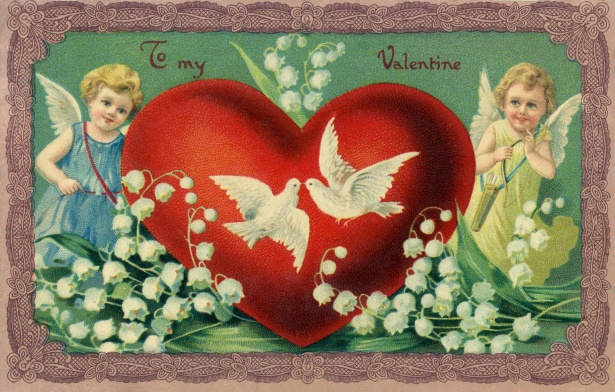The extraordinary history of Valentine’s Day
While cards with hearts and baby angels are what Valentine’s Day is associated with now, that was not always the case. (Public Domain Image)
Valentine’s Day is widely regarded as a day of love and romance, celebrated with heart-shaped boxes of chocolates, red roses and cheesy greeting cards. But the actual history of the holiday — especially the story of St. Valentine, for whom the holiday is named — is convoluted and confusing. In fact, there is so little known about St. Valentine that his feast day is no longer celebrated in the Catholic Church. The little that is known about him definitely does not have anything to do with candy and Baby Cupid. So how is it that St. Valentine ended up becoming the namesake for one of the most popular secular holidays in the United States?
Who was St. Valentine? Historians actually disagree on whether he was just one person. Surprisingly, there were actually multiple men named Valentine martyred on February 14 over the years. Some say St. Valentine was a Roman priest who was martyred in 270 by Emperor Claudius II Gothicus during a persecution of Christians. Others believe he was the bishop of Terni, who was also killed.
Regardless of how he died, there are two stories of St. Valentine that are the basis for our modern holiday. One is that St. Valentine was arrested for his Christianity and, while imprisoned, healed the blind daughter of his jailer. Valentine and the daughter became friends, and he wrote her a letter signed “from your Valentine,” which became the basis for Valentine’s Day cards. The other is that St. Valentine secretly married couples against the order of the emperor to spare the husbands from fighting during wars, because only unmarried men could serve in the Roman Army.
St. Valentine certainly has some romantic stories attached to his name. However, other holidays from before the middle ages may have influenced how we actually celebrate today. Valentine’s Day may be descended from the Roman holiday of Lupercalia, a violent and bawdy celebration of spring and fertility that was celebrated on February 15. Sometime during the 5th century, Pope Gelasius I prohibited Catholics from participating in Lupercalia. Sources dispute whether Gelasius replaced Lupercalia with Candlemas or Valentine’s Day, and whether the pope was even the one to do so. But, it’s known for certain that by the 14th century, Valentine’s Day had become a celebration of love, and by the 1500s, Valentine’s Day cards were a popular tradition. Commercial Valentine’s Day cards were printed starting in the late 1700s, and in 1913, Hallmark started mass printing Valentine’s Day cards.
Even as the holiday’s popularity exploded, St. Valentine himself was removed from the General Roman Calendar, which lists the feast days for saints, in 1969 because so little is known about him. However, St. Valentine is still a saint according to Catholic tradition, and his feast day is February 14 for the Anglican and Lutheran Churches.
Valentine’s Day has changed significantly since its inception. As the years have passed, it has grown from a Catholic feast day into one of the most commercialized holidays in the world. And who knows how much further it will develop? All we can do is hope that Valentine’s Day 1500 years from now will still emphasize the importance of delicious chocolate in heart-shaped boxes.

Claudia is a senior and the Managing Editor of Veritas Shield. She joined journalism as a sophomore. In her free time, she enjoys spending time with her...

